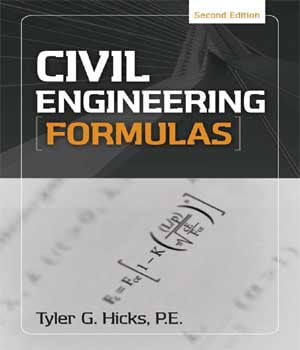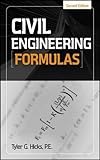Civil Engineering Formulas eBook

Civil Engineering Formulas eBook Many engineers, professional societies, industry associations, and governmental agencies helped the author find and assemble the thousands of formulas presented in this book. Hence, the author wishes to acknowledge this help and assistance.
Civil Engineering Formulas eBook
The formulas presented in this book are intended for use by civil engineers in every aspect of their professional work—design, evaluation, construction, repair, etc.
To find a suitable formula for the situation you face, start by consulting the index. Every effort has been made to present a comprehensive listing of all formulas in the book.
Once you find the formula you seek, read any accompanying text giving background information about the formula. Then when you understand the formula and its applications, insert the numerical values for the variables in the formula. Solve the formula and use the results for the task at hand.
Where a formula may come from a regulatory code, or where a code exists for the particular work being done, be certain to check the latest edition of the applicable code to see that the given formula agrees with the code formula. If it does not agree, be certain to use the latest code formula available.
Remember, as a design engineer you are responsible for the structures you plan, design, and build. Using the latest edition of any governing code is the only sensible way to produce a safe and dependable design that you will be proud to be associated with. Further, you will sleep more peacefully!
 |
|
 |
|
To permit even wider use of this text, this chapter contains the conversion factors needed to switch from one system to the other. For engineers unfamiliar with either system of units, the author suggests the following steps for becoming acquainted with the unknown system:
- Prepare a list of measurements commonly used in your daily work.
- Insert, opposite each known unit, the unit from the other system. Table 1.1 shows such a list of USCS units with corresponding SI units and symbols prepared by a civil engineer who normally uses the USCS. The SI units shown in Table 1.1 were obtained from Table 1.3 by the engineer.
- Find, from a table of conversion factors, such as Table 1.3, the value used to convert from USCS to SI units. Insert each appropriate value in Table 1.2 from Table 1.3.
- Apply the conversion values wherever necessary for the formulas in this book.
- Recognize—here and now—that the most difficult aspect of becoming familiar with a new system of measurement is becoming comfortable with the names and magnitudes of the units. Numerical conversion is simple, once you have set up your own conversion table.
Be careful, when using formulas containing a numerical constant, to convert the constant to that for the system you are using. You can, however, use the formula for the USCS units (when the formula is given in those units) and then convert the final result to the SI equivalent using Table 1.3. For the few formulas given in SI units, the reverse procedure should be used.

Disclaimer:- Dev Library is not the owner of the books and neither does it create books. We just provide the links to the book for the rural and poor students who can’t afford to buy books. Those E-Books and PDFs are already available on the internet. For any reason, if someone thinks that I’m violating any laws or if anyone has any issues regarding this, please feel free to Contact Us.

Hi, I’m Dev Kirtonia, Founder & CEO of Dev Library. A website that provides all SCERT, NCERT 3 to 12, and BA, B.com, B.Sc, and Computer Science with Post Graduate Notes & Suggestions, Novel, eBooks, Biography, Quotes, Study Materials, and more.








